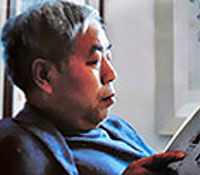
75½"
19½"

Approximate Measurements
Artwork Panel: 31.7cm x 134.6cm ≈ 12½" x 53"
Silk/Brocade: 40.4cm x 191.7cm ≈ 16" x 75½"
Width at Wooden Knobs: 49.4cm ≈ 19½"

Close up view of the artwork mounted to this silk brocade wall scroll




This artwork features two birds alighting on branches that are filled with purple and lavender flowers with hints of pink.
The title is 紫雲飄香 (Zǐ yún piāo xiāng) which literally means "Purple cloud in-the-wind fragrance" but I would more naturally translated it to English as, "Purple cloud, fragrant wind".
紫雲 or "purple clouds" by itself can refer to clouds on which Amida Buddha rides to welcome spirits to Nirvana. 飄香 is a word that often refers to a fragrance that to wafts about.
The inscription and signature read, "辛卯年 碩生" which translates roughly as, "8th-Heavenly-Stem [of the] 4th-Earthly-Branch Year (An indication this was painted in 2011), Shou Sheng".

The Artist, Kang Shuo-Sheng
The artist's name is 康碩生 (Kang Shuo-Sheng). Sometime in the Spring of 2012, I met him in Jinan city which is the capital of Shandong Province in northern China. I loved the detail of his work and picked up a few of his pieces. I often keep good ones like this around for my personal decorating, when I am called to decorate a fancy Chinese restaurant. I've had some of these sealed away in a flat file drawer for more than a few years. I guess it's time, like fine wine, to release these to the public.
Kang Shuo-Sheng was born in 1952 in Shandong province. From a young age, he had great interest in traditional Chinese painting style. His formal art studies began in 1978 at the Shandong Art Institute. His specialty quickly became bird and flower paintings.
Soon after, he opened his own studio and has quite a following in Shandong, and the rest of northern China. After a fellowship at the Tianjin Art Institute in 2001, he developed an interest in emulating the art styles seen during the Yuan, Ming, and early Qing dynasties.